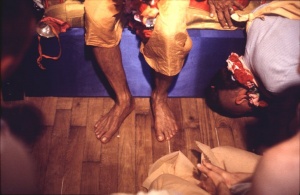CC Madhya 25.47: Difference between revisions
m (1 revision(s)) |
No edit summary |
||
| Line 1: | Line 1: | ||
{{ | [[Category:Sri Caitanya-caritamrta - Madhya-lila Chapter 25|C047]] | ||
<div style="float:left">'''[[Sri Caitanya-caritamrta|Śrī Caitanya-caritāmṛta]] - [[CC Madhya|Madhya-līlā]] - [[CC Madhya 25|Chapter 25: How All the Residents of Vārāṇasī Became Vaiṣṇavas]]'''</div> | |||
<div style="float:right">[[File:Go-previous.png|link=CC Madhya 25.46|Madhya-līlā 25.46]] '''[[CC Madhya 25.46|Madhya-līlā 25.46]] - [[CC Madhya 25.48|Madhya-līlā 25.48]]''' [[File:Go-next.png|link=CC Madhya 25.48|Madhya-līlā 25.48]]</div> | |||
{{CompareVersions|CC|Madhya 25.47|CC 1975|CC 1996}} | |||
{{RandomImage}} | |||
==== TEXT 47 ==== | ==== TEXT 47 ==== | ||
<div | <div class="verse"> | ||
:"ācāryera āgraha-'advaita-vāda' sthāpite | |||
tāte sūtrārtha vyākhyā kare anya rīte | :tāte sūtrārtha vyākhyā kare anya rīte | ||
</div> | </div> | ||
| Line 12: | Line 16: | ||
==== SYNONYMS ==== | ==== SYNONYMS ==== | ||
<div | <div class="synonyms"> | ||
''ācāryera''—of Śaṅkarācārya; ''āgraha''—the eagerness; ''advaita-vāda''—monism; ''sthāpite''—to establish; ''tāte''—for that reason; ''sūtra-artha''—the meaning of the Brahma-sūtra, or Vedānta philosophy; ''vyākhyā''—explanation; ''kare''—does; ''anya rīte''—in a different way. | |||
</div> | </div> | ||
| Line 19: | Line 23: | ||
==== TRANSLATION ==== | ==== TRANSLATION ==== | ||
<div | <div class="translation"> | ||
Prakāśānanda Sarasvatī said, | Prakāśānanda Sarasvatī said, "Śaṅkarācārya was very eager to establish the philosophy of monism. Therefore he explained the Vedānta-sūtra, or Vedānta philosophy, in a different way to support monistic philosophy. | ||
</div> | </div> | ||
__NOTOC__ | |||
<div style="float:right; clear:both;">[[File:Go-previous.png|link=CC Madhya 25.46|Madhya-līlā 25.46]] '''[[CC Madhya 25.46|Madhya-līlā 25.46]] - [[CC Madhya 25.48|Madhya-līlā 25.48]]''' [[File:Go-next.png|link=CC Madhya 25.48|Madhya-līlā 25.48]]</div> | |||
__NOTOC__ | |||
__NOEDITSECTION__ | |||
Revision as of 07:07, 16 September 2021
Śrī Caitanya-caritāmṛta - Madhya-līlā - Chapter 25: How All the Residents of Vārāṇasī Became Vaiṣṇavas

His Divine Grace
A.C. Bhaktivedanta Swami Prabhupada
A.C. Bhaktivedanta Swami Prabhupada
TEXT 47
- "ācāryera āgraha-'advaita-vāda' sthāpite
- tāte sūtrārtha vyākhyā kare anya rīte
SYNONYMS
ācāryera—of Śaṅkarācārya; āgraha—the eagerness; advaita-vāda—monism; sthāpite—to establish; tāte—for that reason; sūtra-artha—the meaning of the Brahma-sūtra, or Vedānta philosophy; vyākhyā—explanation; kare—does; anya rīte—in a different way.
TRANSLATION
Prakāśānanda Sarasvatī said, "Śaṅkarācārya was very eager to establish the philosophy of monism. Therefore he explained the Vedānta-sūtra, or Vedānta philosophy, in a different way to support monistic philosophy.